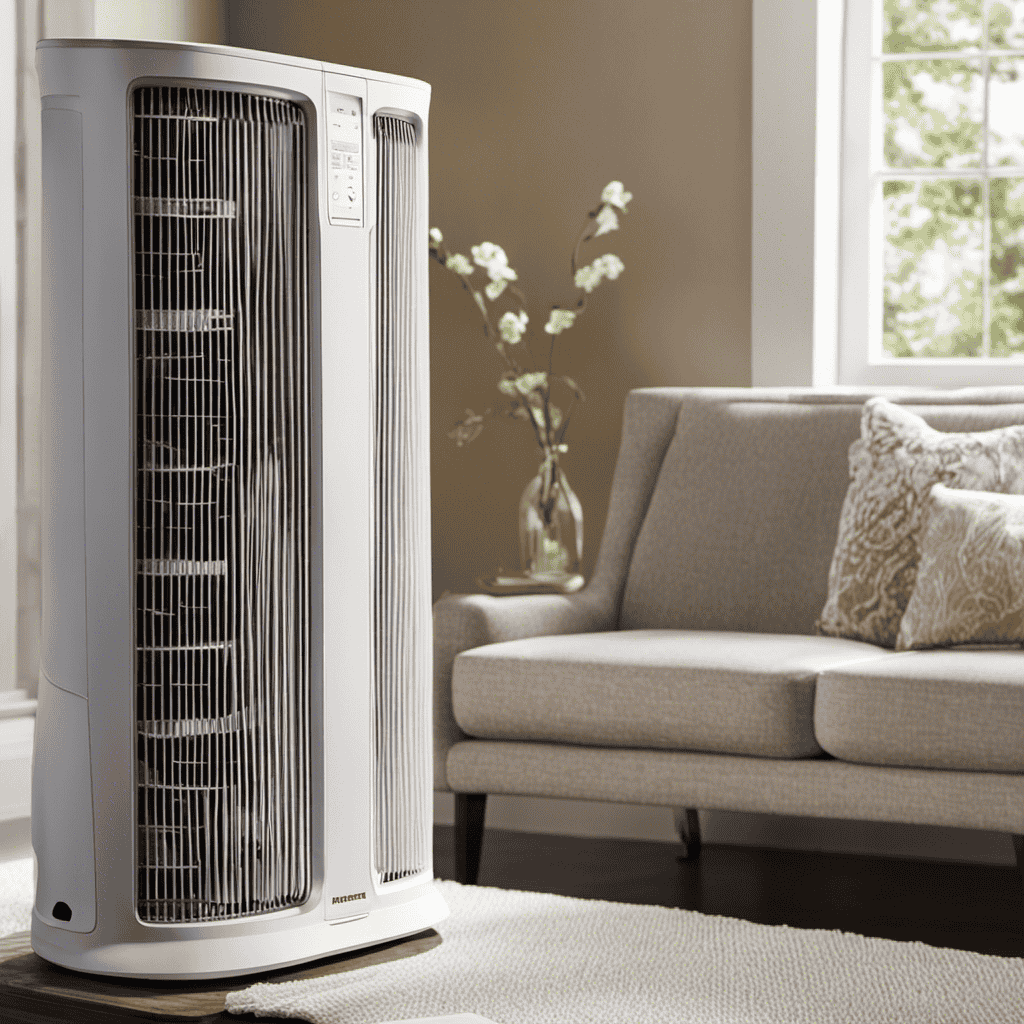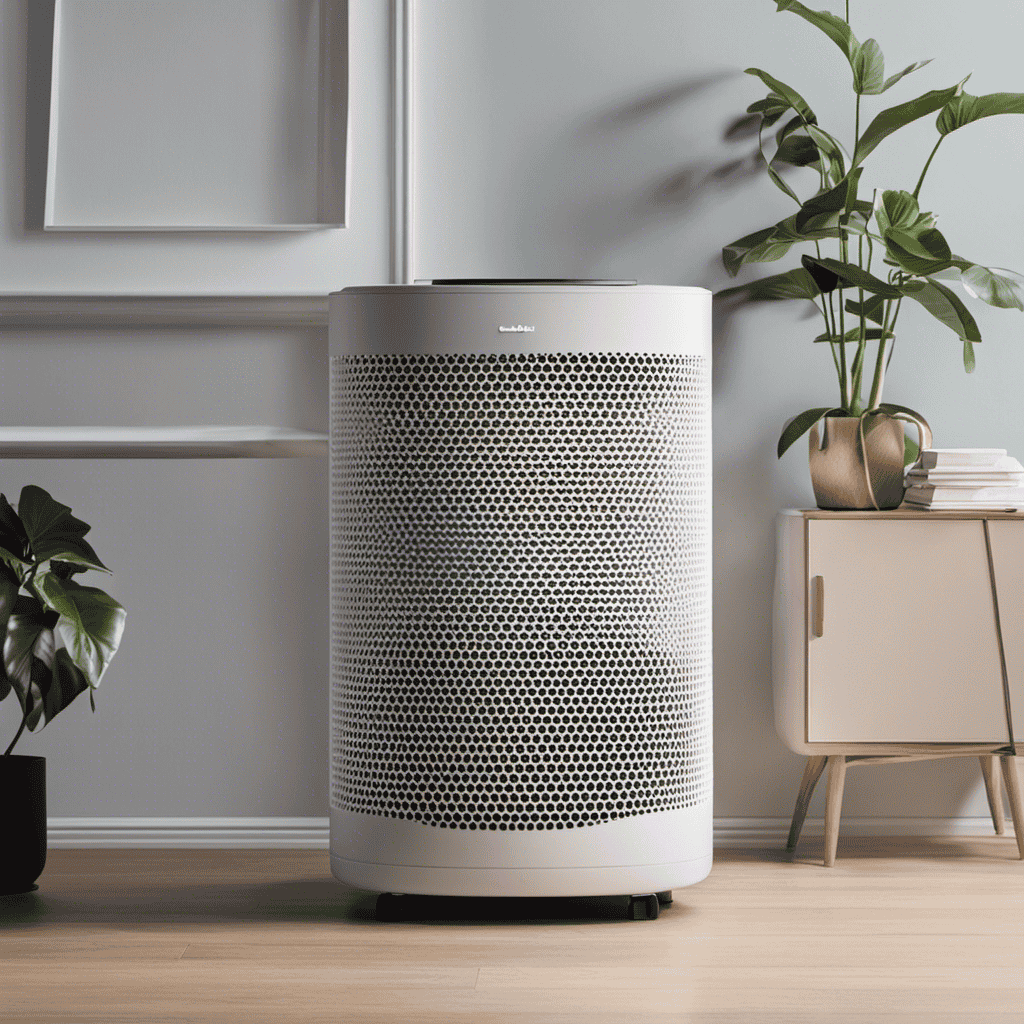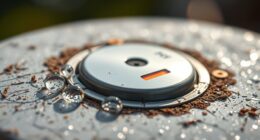As a proud Honeywell air purifier owner, I recognize the significance of maintaining a clean filter to achieve peak performance. Consistent upkeep is essential to guarantee that the air in your home stays pure and free from contaminants.
In this article, I will guide you through the step-by-step process of cleaning your Honeywell air purifier filter. With the right tools and precautions, you’ll be able to extend the lifespan of your filter and enjoy cleaner, healthier air in your living space.
Key Takeaways
- Regularly cleaning the Honeywell air purifier filter is important for optimal performance and improved air quality in your home.
- Cleaning the filter removes dust, pollen, pet dander, and other airborne particles, making it especially important for individuals with allergies or respiratory conditions.
- It is recommended to use a vacuum cleaner with a brush attachment, a soft-bristled brush, mild detergent, warm water, and a clean cloth or sponge for cleaning the filter.
- Precautions should be taken before cleaning, such as turning off and unplugging the air purifier, following manufacturer’s instructions, avoiding harsh chemicals, and being cautious with electronic components.
Why Clean Your Honeywell Air Purifier Filter Regularly
You should clean your Honeywell air purifier filter regularly to ensure it is functioning effectively. Filter maintenance is crucial for the proper operation of your air purifier. Regular cleaning of the filter offers numerous benefits.
Firstly, it improves the overall air quality in your home by removing dust, pollen, pet dander, and other airborne particles. This is especially important for individuals with allergies or respiratory conditions.
Secondly, regular cleaning extends the lifespan of your air purifier, as a clean filter allows the unit to operate more efficiently. Additionally, a clean filter ensures maximum airflow, which enhances the purifier’s performance.
It is essential to keep your filter clean to maintain the effectiveness of your Honeywell air purifier.
Now, let’s move on to the tools and materials needed for cleaning.
Tools and Materials Needed for Cleaning
To start, all you’ll need are some basic tools and materials for the cleaning process.
The tools needed for cleaning your Honeywell air purifier filter include a vacuum cleaner with a brush attachment, a soft-bristled brush, and a mild detergent. These tools will help you effectively remove dust, dirt, and other particles from the filter.
As for the cleaning materials, you will need a clean cloth or sponge, warm water, and a mild detergent. It’s important to avoid using harsh chemicals or abrasive materials that could damage the filter.
Step-by-Step Guide to Removing the Filter
Start by gathering the necessary tools and materials for removing the filter. You will need the following:
- Screwdriver – This will be used to remove any screws holding the filter in place.
- Cleaning brush – A soft-bristled brush will help you remove any dust or debris from the filter.
- Vacuum cleaner – This will be used to clean the surrounding area and remove any loose particles.
- Replacement filter – If your filter is damaged or too dirty to clean, you will need a new one for replacement.
To remove the filter, first, make sure the air purifier is turned off and unplugged. Use the screwdriver to remove any screws securing the filter in place. Carefully take out the filter and set it aside. Inspect the filter for any signs of damage or excessive dirt. If it can be cleaned, use the cleaning brush to gently remove any dust or debris. If it is beyond cleaning, replace it with a new filter.
Remember to follow the manufacturer’s instructions for proper filter maintenance and replacement.
Precautions to Take Before Cleaning
Before beginning the cleaning process, ensure that the air purifier is turned off and unplugged to prevent any accidents. Taking precautions while cleaning your Honeywell air purifier is essential to maintain its efficiency and prolong its lifespan.
Firstly, always refer to the manufacturer’s instructions for specific cleaning techniques and frequency. Most Honeywell air purifiers have washable filters, so it’s important to handle them with care. Gently remove the filter and rinse it with lukewarm water. Avoid using harsh chemicals or scrubbing vigorously, as this can damage the filter. Allow the filter to air dry completely before reinstalling it.
Additionally, be cautious when handling the electronic components of the air purifier and avoid exposing them to water or moisture.
How Often Should You Clean Your Honeywell Air Purifier Filter
Regular maintenance is key to ensuring the optimal performance and longevity of your Honeywell air purifier’s filter. To maintain your Honeywell air purifier filter, follow these steps:
-
Check the filter indicator: Most Honeywell air purifiers are equipped with a filter indicator that will let you know when it’s time to clean the filter.
-
Remove the filter: Turn off the air purifier and unplug it from the power source. Open the front panel and carefully remove the filter.
-
Clean the filter: Gently vacuum the filter to remove dust and debris. If the filter is heavily soiled, you can rinse it with water and allow it to dry completely before reinstalling.
-
Reinstall the filter: Once the filter is clean and dry, place it back into the air purifier and securely close the front panel.
Regularly cleaning your Honeywell air purifier filter is crucial for improved air quality in your home. By removing dust, allergens, and other pollutants, you can breathe cleaner, fresher air.
The Importance of Cleaning the Filter for Improved Air Quality
When it comes to maintaining the performance and longevity of your air purifier, proper filter maintenance is crucial.
In this discussion, I will be sharing some essential filter maintenance tips that will help you keep your air purifier running efficiently.
Additionally, I will explain the health benefits of regularly cleaning your air purifier filter, which include improved air quality and a reduction in airborne allergens and pollutants.
Filter Maintenance Tips
To keep your Honeywell air purifier filter in good condition, make sure to regularly clean and replace it as needed. Here are some cleaning tips to help you maintain the filter and enjoy the health benefits it provides:
-
Vacuum the filter: Use a soft brush attachment to gently remove dust and debris from the surface of the filter. This will help improve its efficiency in capturing airborne particles.
-
Wash the filter: If your filter is washable, follow the manufacturer’s instructions to clean it properly. Use mild soap and water to remove dirt and allergens, and allow it to dry completely before reinstalling.
-
Replace the filter: Even with regular cleaning, filters can become clogged over time. Replace the filter according to the manufacturer’s recommendations to ensure optimal performance and clean air quality.
-
Keep the area clean: Regularly dust and vacuum the surrounding area to minimize the accumulation of dirt and dust on the filter, helping it to work more effectively.
Health Benefits of Cleaning
By following these tips, you can make sure your Honeywell air purifier filter remains in good condition and provides you with the health benefits of clean air.
Regular cleaning techniques are essential to maintain the effectiveness of your air purifier. Cleaning the filter not only improves its performance but also ensures that the air you breathe is free from harmful particles and allergens.
A clean filter traps dust, pollen, pet dander, and other pollutants, preventing them from circulating in your home. This reduces the risk of respiratory illnesses, allergies, and asthma attacks, promoting better overall health.
Additionally, clean air can enhance sleep quality, boost energy levels, and improve cognitive function. So, don’t overlook the importance of cleaning your Honeywell air purifier filter regularly to enjoy the numerous benefits of breathing clean and fresh air.
Understanding the Different Types of Honeywell Air Purifier Filters
Understanding the different types of Honeywell air purifier filters can help you choose the most suitable one for your needs. Here are the main types of filters you can find:
-
HEPA (High-Efficiency Particulate Air) Filter: This type of filter is highly effective at removing microscopic particles such as dust, pollen, pet dander, and smoke from the air. It can help reduce allergies and asthma symptoms.
-
Carbon Filter: This filter is designed to remove odors, gases, and chemical vapors from the air. It is especially useful in households with smokers or pets.
-
Pre-Filter: This filter is the first line of defense, capturing larger particles like hair and dust. It helps prolong the lifespan of the main filter and enhances overall air purification efficiency.
-
UV-C Light: Some Honeywell air purifiers also feature a UV-C light that kills bacteria and viruses, providing an extra layer of protection against airborne pathogens.
How to Identify When Your Filter Needs Cleaning
When it comes to maintaining the efficiency of my air purifier, it is important to be aware of the signs that indicate a dirty filter. By regularly checking for these signs, such as reduced airflow or a noticeable increase in dust particles in the air, I can ensure that my filter is effectively capturing pollutants.
As for the frequency of filter cleaning, it is recommended to clean or replace the filter every three to six months, depending on the usage and air quality in my environment.
Signs of Dirty Filter
You can easily tell if your Honeywell air purifier filter is dirty by checking for signs such as reduced airflow and a musty odor. Keeping your air purifier filter clean is essential for maintaining its efficiency and ensuring clean air in your home.
Here are some signs to look out for:
-
Reduced Airflow: If you notice that the airflow from your air purifier has decreased, it may be a sign that the filter is clogged with dirt and debris.
-
Musty Odor: A dirty filter can emit a musty smell, indicating that it is no longer effectively trapping pollutants and allergens.
-
Dust Accumulation: If you see a buildup of dust on the surface of your air purifier or around the vents, it is a clear indication that the filter needs cleaning.
-
Decreased Performance: A dirty filter can lead to reduced performance of your air purifier, making it less effective at removing airborne particles.
Regularly cleaning your Honeywell air purifier filter can prevent these issues and provide several benefits, such as improved indoor air quality and increased longevity of your purifier. By maintaining a clean filter, you ensure that your air purifier works optimally to keep the air in your home clean and healthy.
Now that you know the signs of a dirty filter, let’s discuss how frequently you should clean your Honeywell air purifier filter.
Frequency of Filter Cleaning
In my experience, it is crucial to understand the frequency at which you should clean your Honeywell air purifier filter. The filter cleaning frequency depends on several factors, such as the air quality in your surroundings, the number of people in your household, and the presence of pets or smokers.
As a general rule, I recommend cleaning the filter every three to six months. However, if you notice reduced airflow or a musty odor, it may be necessary to clean the filter more frequently.
Regular cleaning of the filter offers numerous benefits. It improves the efficiency of the purifier, ensuring that it effectively captures airborne particles. Additionally, it enhances the lifespan of the filter, optimizing its performance and prolonging its replacement interval.
Cleaning Tips for Different Honeywell Air Purifier Models
For cleaning different models of Honeywell air purifiers, it’s important to follow these tips.
-
Use a soft brush or vacuum cleaner attachment to gently remove dust and debris from the exterior of the air purifier. This will help maintain its appearance and prevent the accumulation of allergens.
-
Refer to the user manual to determine the specific maintenance requirements for your particular model. Different Honeywell air purifiers may have different filter types and cleaning methods.
-
Regularly clean or replace the pre-filter, as it plays a crucial role in capturing larger particles and prolonging the life of the main filter.
-
Clean the main filter according to the manufacturer’s instructions. This will ensure that it continues to effectively remove pollutants from the air, providing you with the health benefits of cleaner indoor air.
By following these cleaning tips, you can ensure the proper maintenance of your Honeywell air purifier and enjoy the health benefits it provides.
Now, let’s discuss some common mistakes to avoid when cleaning the filter.
Common Mistakes to Avoid When Cleaning the Filter
When it comes to cleaning the filter of your Honeywell air purifier, it’s important to avoid certain common mistakes.
Incorrect cleaning methods can damage the filter and reduce its efficiency in trapping airborne particles.
Additionally, skipping regular maintenance can lead to a buildup of dirt and contaminants, decreasing the overall performance of the air purifier.
Incorrect Cleaning Methods
Using harsh chemicals or scrubbing too vigorously can damage the Honeywell air purifier filter. It is important to avoid these common cleaning mistakes to ensure the longevity and effectiveness of your filter.
Here are some alternative cleaning methods that you can use:
-
Vacuuming: Gently vacuum the surface of the filter to remove dust and debris. Make sure to use a soft brush attachment to avoid damaging the delicate filter material.
-
Rinsing with water: You can rinse the filter with water to remove dirt and particles. Be sure to use lukewarm water and gently rinse from both sides. Allow the filter to dry completely before reinstalling.
-
Using compressed air: If your filter is not heavily soiled, you can use compressed air to blow away dust and debris. Make sure to use low pressure and hold the canister at a safe distance to avoid damaging the filter.
-
Cleaning with a mild detergent: For stubborn stains or odors, you can mix a mild detergent with water and gently scrub the filter. Rinse thoroughly and let it dry completely before reinstalling.
Skipping Regular Maintenance
Regular maintenance is crucial for ensuring the longevity and effectiveness of your air purifier. Neglecting this important task can lead to reduced performance and potentially harmful air quality. To help you stay on top of your air purifier maintenance, I have created a handy table comparing two alternative cleaning methods: vinegar and soap.
| Cleaning Method | Advantages | Disadvantages |
|---|---|---|
| Vinegar | Natural and non-toxic, effectively removes dirt and grime | Strong odor, may not be as effective on tough stains |
| Soap | Widely available, easy to use, can be combined with water for better cleaning | Can leave residue if not rinsed properly, may contain synthetic ingredients |
When cleaning your air purifier, it’s important to choose a method that suits your preferences and needs. Both vinegar and soap offer their own set of advantages and disadvantages. Ultimately, the choice is yours to make.
How to Properly Rinse and Dry the Filter
To properly rinse and dry your filter, make sure you gently shake off any excess water before allowing it to air dry completely. Here are the steps to follow:
-
Shake off excess water: After cleaning the filter with a mild detergent or cleaning solution, shake off any excess water to ensure it doesn’t drip or pool.
-
Place it in a well-ventilated area: Find a location where the filter can air dry completely. Avoid direct sunlight or heat sources as they may damage the filter.
-
Wait for it to dry completely: Depending on the humidity levels, it may take several hours for the filter to dry completely. Be patient and ensure it is fully dry before reinstalling it in the air purifier.
-
Avoid using it until dry: It’s important to let the filter air dry completely before using it again to prevent any potential damage or reduced efficiency.
Now that you know how to properly rinse and dry the filter, let’s explore some alternative methods for cleaning the Honeywell air purifier filter.
Alternative Methods for Cleaning the Honeywell Air Purifier Filter
When it comes to cleaning the Honeywell air purifier filter, there are two common methods that people often debate about: using vinegar or soap.
Vinegar is known for its natural cleaning properties and can effectively remove dirt and debris from the filter.
On the other hand, soap is a more traditional option that can also do a good job at cleaning the filter.
In this discussion, I will compare vinegar and soap as cleaning agents for DIY filter cleaning and explore their effectiveness and potential drawbacks.
Vinegar Vs. Soap
Using vinegar or soap is a common debate when it comes to cleaning a Honeywell air purifier filter. Both options have their advantages and effectiveness in removing dirt, dust, and other pollutants from the filter.
Here’s a breakdown of the benefits of vinegar and the effectiveness of soap:
-
Vinegar benefits:
- Natural disinfectant: Vinegar has antimicrobial properties that can kill germs and bacteria.
- Deodorizer: It helps eliminate unpleasant odors from the filter.
- Safe for the environment: Vinegar is non-toxic and environmentally friendly.
- Cost-effective: Vinegar is an affordable cleaning solution.
-
Soap effectiveness:
- Grease and grime remover: Soap can effectively remove oily residues and sticky substances from the filter.
- Deep cleans: It can penetrate the filter fibers to remove embedded dirt and debris.
- Removes allergens: Soap can help eliminate allergens like pollen and pet dander.
DIY Filter Cleaning?
Now that we have compared the effectiveness of vinegar and soap for cleaning Honeywell air purifier filters, let’s discuss some do-it-yourself (DIY) cleaning tips and effective cleaning methods.
DIY cleaning is a cost-effective way to maintain the performance of your air purifier filter. One effective method is to use a vacuum cleaner with a brush attachment to remove large particles and debris from the filter. You can also gently tap the filter against a hard surface to dislodge any trapped dirt.
For deeper cleaning, you can create a mixture of mild dish soap and warm water and gently scrub the filter using a soft brush or sponge. Remember to rinse the filter thoroughly and allow it to dry completely before reinstalling it in your air purifier.
By following these DIY cleaning tips and effective cleaning methods, you can ensure that your Honeywell air purifier filter stays in optimal condition.
Now, let’s move on to the next section where we will discuss how to extend the lifespan of your Honeywell air purifier filter.
How to Extend the Lifespan of Your Honeywell Air Purifier Filter
To extend the lifespan of your Honeywell air purifier filter, it’s important to regularly clean and maintain it. Here are four steps to help maximize the efficiency and longevity of your filter:
-
Vacuum the pre-filter: Use a vacuum cleaner with a brush attachment to gently remove dust and debris from the pre-filter. This will prevent it from clogging the main filter.
-
Wash the main filter: If your filter is washable, carefully remove it from the air purifier and rinse it under running water. Allow it to air dry completely before reinstalling.
-
Replace when necessary: Even with regular cleaning, filters have a limited lifespan. Check the manufacturer’s guidelines for recommended replacement intervals and replace the filter as needed.
-
Keep the air purifier clean: Dust and dirt can accumulate on the exterior of the air purifier, hindering its performance. Wipe it down regularly with a soft, damp cloth to keep it clean and functioning optimally.
Troubleshooting: What to Do if Your Filter Doesn’t Seem Clean After Cleaning
If your filter doesn’t appear clean after you’ve cleaned it, there may be some troubleshooting steps you can try. Two common issues you might encounter are filter clogs and filter discoloration. In the case of filter clogs, you can try tapping the filter gently to dislodge any trapped debris or using a soft brush to remove stubborn particles. If the filter is still discolored after cleaning, it may be time to replace it with a new one. To help you troubleshoot these issues, refer to the table below:
| Issue | Troubleshooting Steps |
|---|---|
| Filter Clogs | 1. Tap the filter gently to dislodge debris |
| 2. Use a soft brush to remove stubborn particles | |
| Filter Discoloration | 1. Try cleaning the filter with mild soap and water |
| 2. If discoloration persists, replace the filter |
Is the Process for Cleaning the Honeywell Air Purifier Filter the Same as Other Air Purifiers?
Yes, the process for cleaning the Honeywell air purifier filter is similar to other air purifiers. Start by turning off the unit and removing the filter. Use a soft brush or vacuum to gently remove dust and debris. Then, wash the filter with mild soap and water, and let it thoroughly dry before putting it back in place. Regular cleaning is essential for optimal performance.
Reinstalling the Filter: Step-by-Step Guide
Reinstalling the filter is a straightforward process that can be done in just a few simple steps. Here’s a step-by-step guide to help you with the process:
- Turn off the air purifier and unplug it from the power source to ensure safety.
- Open the front cover or access panel to gain access to the filter compartment.
- Carefully remove the old filter from its housing and dispose of it properly.
- Take the new filter and align it correctly in the housing, making sure it fits snugly.
When it comes to filter replacement options, Honeywell offers a range of choices to suit your needs. You can choose from HEPA filters for capturing allergens, activated carbon filters for removing odors, or even a combination of both. Make sure to follow the manufacturer’s guidelines for filter compatibility and replacement intervals.
With these simple techniques and filter replacement options, you can ensure your Honeywell air purifier continues to provide clean and fresh air.
Frequently Asked Questions
Can I Use Any Type of Cleaning Solution to Clean My Honeywell Air Purifier Filter?
I wouldn’t use any type of cleaning solution on my Honeywell air purifier filter. It’s best to follow the manufacturer’s instructions for cleaning and use recommended cleaning practices to ensure optimal performance and longevity of the filter.
Can I Vacuum My Honeywell Air Purifier Filter Instead of Washing It?
Vacuuming my Honeywell air purifier filter is a viable alternative to washing it. It effectively removes dust and debris, ensuring optimal performance. However, it’s important to consider the filter’s condition and manufacturer’s recommendations before choosing this method.
How Long Does It Take for a Honeywell Air Purifier Filter to Dry After Cleaning?
After cleaning the Honeywell air purifier filter, it is important to let it dry completely before reinstalling. To dry efficiently, place the filter in a well-ventilated area for at least 24 hours. Regular cleaning helps maintain filter longevity.
Is It Necessary to Clean the Pre-Filter of My Honeywell Air Purifier as Well?
When it comes to cleaning my Honeywell air purifier, I always make sure to clean the pre-filter as well. It’s an essential step in maintaining its efficiency and prolonging its lifespan. Here are some cleaning tips and a maintenance guide.
Can I Use Compressed Air to Clean My Honeywell Air Purifier Filter?
Yes, you can use compressed air to clean your Honeywell air purifier filter. Regular cleaning with compressed air helps remove dust and debris, ensuring optimal performance and prolonging the lifespan of the filter.
Conclusion
In conclusion, regularly cleaning your Honeywell air purifier filter is crucial for maintaining its effectiveness and prolonging its lifespan. By following the step-by-step guide and taking necessary precautions, you can ensure that your filter remains clean and efficient.
Did you know that indoor air can be up to 5 times more polluted than outdoor air? This statistic highlights the importance of having a clean air purifier filter to improve the air quality in your home and protect your health.
So, take the time to clean your filter regularly and breathe in fresh, clean air.










